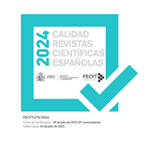Sobre la marcación del discurso en español
Resumen
Al usar el lenguaje no solo transmitimos contenidos sobre la realidad, hay otras dimensiones del lenguaje que dan cuenta de que también expresamos nuestra actitud hacia lo que decimos (significado modal), hacia el receptor (significado interaccional) y también hablamos sobre el texto que producimos (significado textual). En este sentido, denominamos marcación del discurso a una macrofunción mediante la que el emisor se hace presente en el enunciado para manifestar su relación con el receptor, la organización de su discurso y su subjetividad. El término de marcación del discurso se utiliza frecuentemente, pero casi siempre relacionado con los marcadores discursivos. A nuestro juicio, el término puede tener una interpretación más amplia, no exclusivamente relacionada con los marcadores discursivos, puesto que lo que denominamos marcación del discurso puede ser llevado a cabo mediante procedimientos y unidades muy variados. En la presente contribución, nos ocupamos de lo que podemos denominar la marcación del discurso, ofreciendo una propuesta de modelo sobre las diferentes funciones que es necesario distinguir y las unidades con las que las realizamos.Descargas
Descarga artículo
Licencia
La revista Círculo de Lingüística Aplicada a la Comunicación, para fomentar el intercambio global del conocimiento, facilita el acceso sin restricciones a sus contenidos desde el momento de su publicación en la presente edición electrónica, y por eso es una revista de acceso abierto. Los originales publicados en esta revista son propiedad de la Universidad Complutense de Madrid y es obligatorio citar su procedencia en cualquier reproducción total o parcial. Todos los contenidos se distribuyen bajo una licencia de uso y distribución Creative Commons Reconocimiento 4.0 (CC BY 4.0). Esta circunstancia ha de hacerse constar expresamente de esta forma cuando sea necesario. Puede consultar la versión informativa y el texto legal de la licencia.











